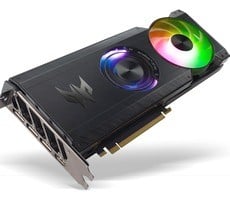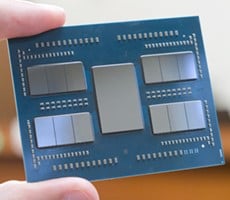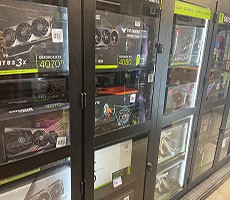Acer Predator BiFrost Arc A770 OC Graphics Card Review: Intel On-Board
Our Test System Configuration:
| Hardware Used: AMD Ryzen 7 5800X3D (3.4GHz - 4.5GHz, 8-Core) ASRock X570 Taichi 32GB G.SKILL DDR5-6000 Intel Optane 905P Integrated Audio / Network Acer Predator BiFrost Arc A770 OC Radeon RX 7600 Radeon RX 6750 XT GeForce RTX 4060 Ti GeForce RTX 3060 Ti GeForce RTX 3060 Relevant Software: Windows 10 Pro 22H2 AMD Radeon Adrenalin Software v23.9.3 NVIDIA GeForce driver 537.42 Intel Arc Graphics driver v101.4887 |
Compute / Rendering Benchmarks: LuxMark v4 Blender v3.6.0 Blackmagic RAW Speed Test v3 IndigoBench v4.4.15 Gaming / Graphics Benchmarks: UL 3DMark Baldur's Gate 3 Counter-Strike 2 Phantasy Star Online 2: New Genesis Starfield Resident Evil 4 Remake Elden Ring F1 23 Ratchet & Clank: Rift Apart Hogwarts Legacy Cyberpunk 2077 |
LuxMark v4.0 Benchmarks
LuxMark is a cross-platform, OpenCL-accelerated 3D rendering benchmark. It's a tool based on the open source LuxRender physically-based spectral rendering engine, which accurately models the transportation of light and supports high dynamic range. LuxRender features a number of material types to allow rendering of photo-realistic and artistic scenes. LuxRender is free software, licensed under the GPL, that offers plugins for packages like Blender, Maya, Cinema 4D and 3DS Max.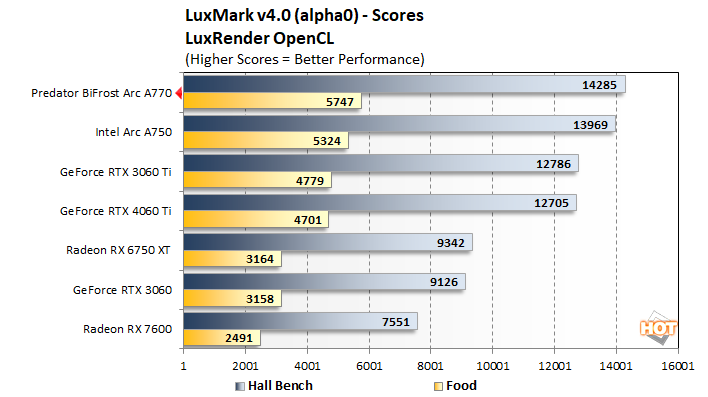
Arc starts off with a very strong showing here. Both Arc cards rocket to the top of our performance charts, providing excellent speed in the open-source LuxCore renderer. This isn't always the case in OpenCL benchmarks, but at least in the case of LuxMark, it runs well on Intel's GPUs.
IndigoBench Rendering Benchmarks
IndigoBench is another OpenCL-based rendering benchmark, this time based on Indigo's own production-quality renderer. It tests two scenes, a high-poly sports car model and then an extremely detailed bedroom scene, and then it presents results in millions of samples per second.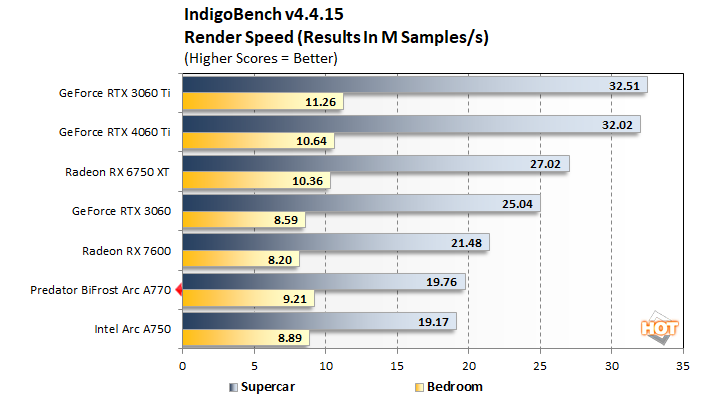
In a near-complete reversal, Arc fares poorly in this test. IndigoBench favors GeForce cards, it seems, although the beefy Navi 22 GPU in the Radeon RX 6750 XT allows it to perform well, too. While Arc does relatively poorly in the simpler Supercar scene, don't let its position the chart distract you from the fact that the A770 is within striking distance of the RX 6750 XT in the Bedroom benchmark, and well ahead of the two smaller GPUs in our testing, so this isn't exactly a "bad" result.
Blender v3.6.0 GPU Rendering Benchmarks
Blender is a free and open-source 3D creation suite that can handle everything from modeling, rigging, animation, and simulation, all the way to rendering, compositing, motion tracking, and even video editing and game creation. While Blender supports many different renderers—including both LuxCoreRender and Indigo—the developers offer a standalone benchmarking tool that uses Blender's own Eevee renderer. It tests three scenes: a cute blobby monster, a shop full of junk, and then a detailed classroom model.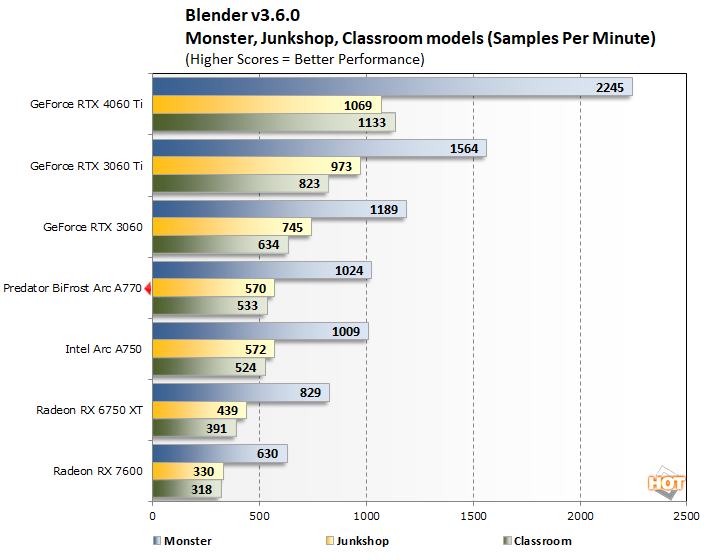
Blender's Eevee renderer has always been the domain of NVIDIA, as it heavily favor's the green team's cards over anyone else's. With that said, Arc performs reasonably well here, all things considered. Both Arc cards handily defeat their Radeon competition, and the A770 is only a few steps behind the GeForce RTX 3060. Of course, the high-clocked RTX 4060 Ti dominates here, but that's not really surprising.
Blackmagic RAW Speed Test Results
Finally, our last production benchmark is the Blackmagic RAW Speed Test. It's a CPU and GPU benchmarking tool that tests the speed of decoding full-resolution Blackmagic RAW (BRAW) frames. Despite the name, BRAW is not actually raw video, but rather a "visually lossless" encoding format that allows video shops to work with full-frame 8K video without the enormous file sizes that true RAW video would require. This benchmark tests with OpenCL or CUDA on supported GPUs, and we're reporting the results for 8K video at 12:1 compression and 3:1 compression.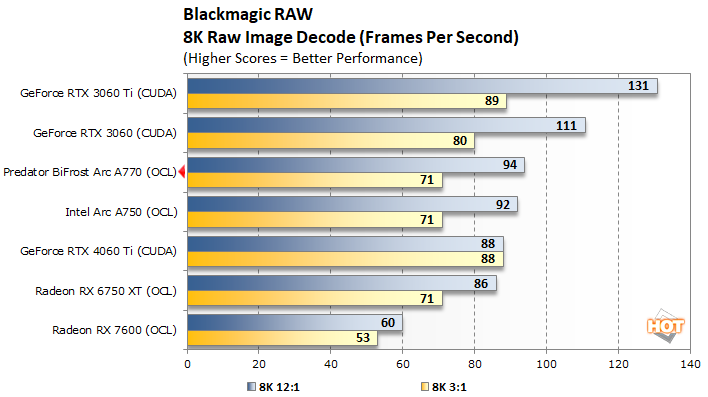
Intel's OpenCL drivers for Arc are clearly well tuned, as both of the Intel GPUs dominate their red-team competition here. The GeForce RTX 4060 Ti does surprisingly poorly, and we suspect that's down to its mediocre memory bandwidth. Meanwhile, both Ampere GPUs pull away from the Arc cards a bit, but that's likely due to superior optimization in the CUDA path for Blackmagic's RAW decoder.

